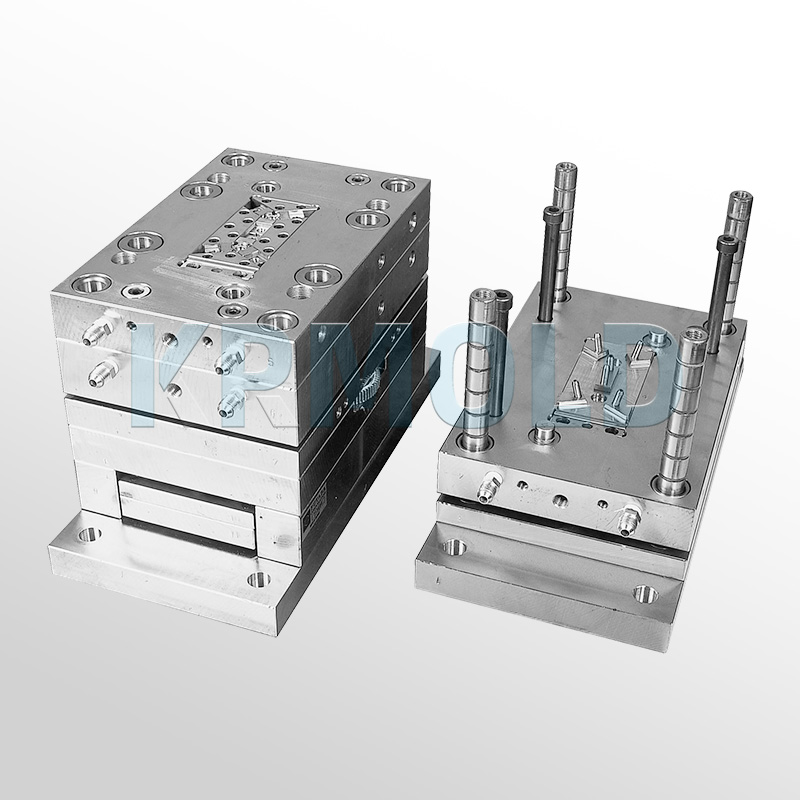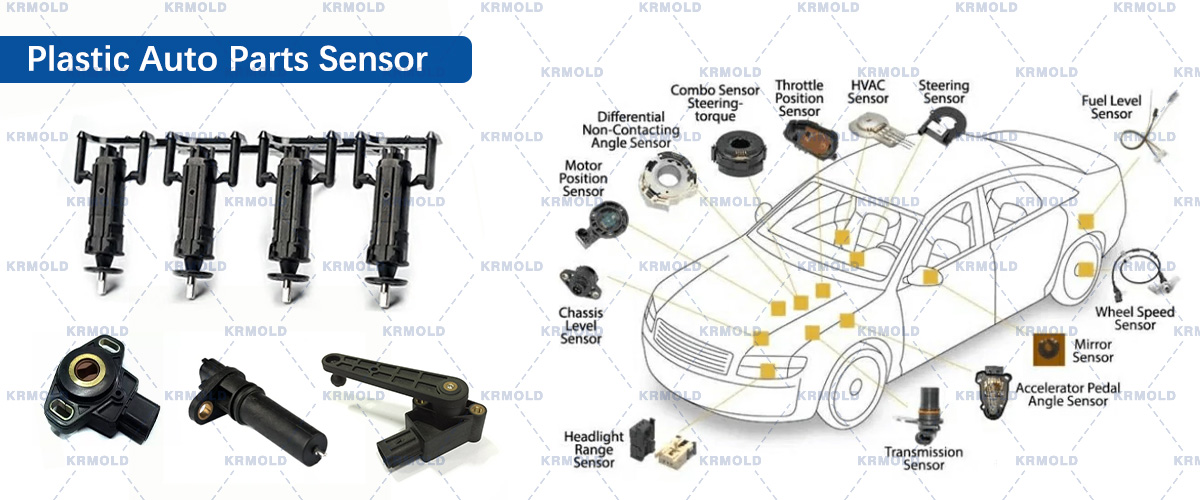Introduction to Plastic Auto Parts Sensor Injection Mold
——
KRMOLD plastic auto parts sensor injection molds produce a wide range of auto sensor injection parts, including those for temperature sensor, pressure sensor, oxygen sensor, speed sensor, position sensor, acceleration sensor, and light sensor. KRMOLD high-quality auto sensor parts injection molds produce precise and durable automotive sensor components designed to improve vehicle safety, performance, and comfort, ensuring optimal performance for every vehicle during driving.
As a professional manufacturer of plastic auto parts sensor injection molds, KRMOLD has accumulated extensive experience in the design and manufacture of auto sensor parts injection molds. KRMOLD team can provide customized plastic auto parts sensor injection mold design services based on specific customer needs, ensuring the quality and performance of the final product.

Working Principle of Auto Sensor Parts Injection Mold
——
KRMOLD plastic auto parts sensor injection molds utilize advanced injection molding technology. The injection molding machine injects heated and molten plastic into the mold cavity. After the auto sensor parts injection mold closes, the plastic cools and solidifies under specific pressure and temperature, ultimately forming an automotive sensor plastic part that conforms to the shape of the mold cavity. After plastic auto parts sensor injection mold opening, the molded plastic part is ejected by an ejector mechanism. This process is efficient and precise, ensuring high-quality production of automotive sensor injection parts.
Parameter of Plastic Auto Parts Sensor Injection Mold
——
| name | Auto sensor parts injection mold |
| color | white,black,green,nature,blue,yellow,etc |
| material | PP, PA,PC,PPT,ABS,PA+GF,POM,PE,UPE,PTFE,etc |
| mould cavity | single cavity & multi cavity |
| runner system | hot runner and cold runner |
| equipment | CNC, EDM, cutting off machine,plastic machinery etc |
| mould material | P20/ 718H/ S136H/ S136 hardened/ NAK80 |
| injection machine | 30T,50T,60T,80T, 90T, 120T, 168T, 200T, 380T |
| mould life | 500000-5000000 shots as per customers' requirement |
| size | customized |
| tolerance | ± 0.01mm |
| shape | as per your drawing or the sample |
| certification | IATF 16949 and relate whole set professional test report |
| free sample | available |
| advantage | one stop procurement |
Advantages of Auto Sensor Parts Injection Mold
——
1. High production efficiency
KRMOLD plastic auto parts sensor injection molds are particularly suitable for mass production, enabling rapid molding of high-quality automotive sensor plastic parts. This high-efficiency production capacity not only meets the automotive industry's demand for large-scale production but also significantly shortens delivery cycles, allowing customers to meet market demands promptly.
2. High dimensional accuracy
KRMOLD auto sensor parts injection molds can precisely control the dimensions of plastic parts, ensuring the stability and consistency of product quality. This high-precision characteristic meets the stringent requirements of sensor assembly, avoiding assembly problems caused by dimensional errors.
3. Capable of molding complex shapes
KRMOLD plastic auto parts sensor injection mold design can manufacture sensor plastic parts with complex shapes and internal structures. For example, sensor components with various slots, bosses, and other structures can all be precisely realized using KRMOLD auto sensor parts injection molds.


Key Design Considerations for Auto Sensor Parts Injection Mold
——
1. Precision design for auto sensor parts injection mold
(1) Dimensional Accuracy Requirements
When designing plastic auto parts sensor injection mold, KRMOLD engineers accurately calculate and determine the dimensions of the mold cavity and core based on the dimensional tolerance requirements of the automotive sensor injection parts. Automotive sensor injection parts typically have extremely high dimensional accuracy requirements, making auto sensor parts injection mold dimension accuracy crucial. KRMOLD employs high-precision machining equipment, such as CNC machining centers, with micron-level precision, to ensure plastic auto parts sensor injection mold dimensional accuracy.
(2) Form and Position Accuracy Design
Auto sensor parts injection mold form and position accuracy includes shape accuracy and positional accuracy. The shape accuracy of the mold cavity must precisely match the design requirements of the automotive sensor injection parts. Advanced 3D modeling software is used for mold cavity design and simulation analysis to ensure the smoothness and accuracy of the surfaces. During machining, KRMOLD staff utilize EDM and high-speed milling processes to ensure high precision in the cavity shape. Furthermore, positional accuracy primarily involves the relative positional relationships between various components within the plastic auto parts sensor injection mold. High-precision positioning devices, such as precision positioning blocks and tapered positioning pins, are used to ensure that the positional accuracy between components is within the allowable tolerance range.
2. Parting surface design for auto sensor parts injection mold
(1) Parting Surface Location Selection
The location of the parting surface has a critical impact on the quality and appearance of precision injection molded automotive parts. KRMOLD engineers avoid placing the parting surface in important areas of the injection molded part's appearance or in critical areas affecting its function. Furthermore, considering the demolding method of the injection molded part, the parting surface should facilitate smooth demolding. By combining side core pulling or inclined ejector mechanisms, it is ensured that the injection molded part can be smoothly ejected from the mold during the mold opening process, avoiding deformation or damage caused by uneven demolding force.
(2) Parting Surface Shape Design
The parting surface can be in various forms, such as a plane, inclined plane, or curved surface. KRMOLD engineers rationally design the parting surface shape based on the shape and structural characteristics of the plastic auto parts sensor injection molded parts. Meanwhile, KRMOLD engineers also focus on the sealing of the parting surface to prevent molten plastic from overflowing during injection molding. By designing a reasonable parting surface sealing structure, such as using sealing grooves and sealing rings, they ensure that molten plastic does not leak from the parting surface during high-pressure injection molding, thus preventing leakage and ensuring the quality and dimensional accuracy of the molded parts.

KRMOLD Auto Sensor Parts Injection Mold Manufacturing Process
——
-Mold Design: Based on the design requirements, dimensional accuracy, and production volume of the automotive sensor plastic parts, and taking into account factors such as injection molding machine specifications and plastic material properties, the plastic auto parts sensor injection mold structure, dimensions, and details of each component are designed.
-Machining: Using CNC machining, EDM (Electrical Discharge Machining), wire cutting, deep hole drilling, and other processes, the raw materials such as mold steel are machined to manufacture various parts.
-Fitter Assembly: Fitters grind and assemble the machined parts, checking the smooth movement of ejector pins, sliders, and other components, and ensuring there are no interference issues with the auto sensor parts injection mold.
-Polishing and finishing: Using tools and materials such as sandpaper, oilstone, and diamond paste, polish the product's exterior surfaces and other areas of the plastic auto parts sensor injection mold parts to improve the mold surface quality and ensure the appearance of the plastic parts.
-Inspection and trial molding: Conduct trial molding using an injection molding machine to check whether the auto sensor parts injection mold operates normally and whether the product structure and quality meet the standards. Provide a trial molding process parameter report, etc.
-Mold modification and repair: Based on the trial molding results, if there are problems with the product, adjust and modify the plastic auto parts sensor injection mold to meet production requirements.
Specify the type of plastic (e.g. PP, ABS) and post-processing requirements (e.g. spraying, silk-screen printing), and provide 2D or 3D plastic part drawings should be provided. At the same time, provide the production volume, appearance requirements, tolerance standards, etc.
Generally speaking, our engineers will start to prepare the quotation immediately after the customer provides the complete production requirements. Usually it takes about 1-3 days.
The lead time for regular injection molds is usually 30-60 days, and may be longer for complex molds. For example, the typical lead time for liquid silicone molds is around 60 days, covering design, manufacturing, mold testing, etc.
High-precision processing technology: High-precision equipment such as CNC machining centers (CNC) and electric discharge machining (EDM) are used to optimize the design process in combination with CAD/CAM software. Quality control: Inspection of key dimensions of the mold by Coordinate Measuring Machine (CMM) and verification of multiple sample batches during the trial molding stage. Material Selection: Use die steel with high wear resistance (e.g. H13, S136) and surface treatment (e.g. nitriding, chrome plating) for die nuts to extend the life.
After every 50,000 molds, check the guide pillar, ejector pin and other wear parts, and clean up the residual plastic and rust on the mold surface. Use high temperature grease for sliding parts (e.g. tilt top, slider) to reduce friction loss. Ensure that the water circuit is smooth and the temperature difference is ≤5℃ to avoid cracking of the mold due to thermal stress.
Mould cost of materials accounted for about 30-40% (such as 1 ton of P20 steel price of about 20,000 yuan), processing costs accounted for more than 50% (CNC labor hourly rate of about 80-150 yuan / hour). Small batch production can choose aluminum mold or simplify the structural design; more than 100,000 pieces is recommended to use carbide inserts to enhance life!
Mould injection products need to fully meet the design requirements (such as size, appearance), and can be continuous and stable production. Mold marking, inspection reports (such as material hardness test) and engineering drawings should be complete.
Mould steel (such as S136H, NAK80 and other imported materials cost more) and the type of mold embryo (aluminum mold short-term cost is low but short life) directly affect the cost, the use of CAD/CAE/CAM design technology, hot runner system, etc. will increase the upfront investment, but can enhance the long-term benefits (such as reducing the sprues, increase production capacity).